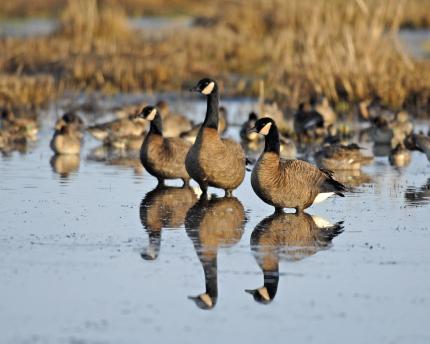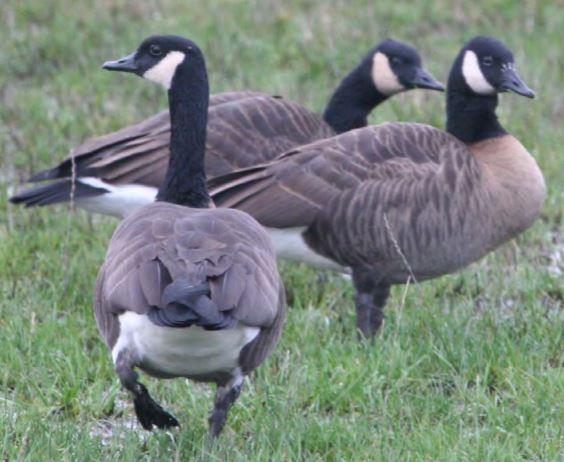Low-
Moderate
The dusky Canada goose is a subspecies of Canada goose. Habitat changes on the dusky Canada goose breeding grounds on the Copper River Delta, Alaska have led to high predation pressure; combined with losses of wintering habitat in western Washington, these factors are responsible for a long-term population decline for this subspecies.
Dusky Canada goose is managed as a migratory game bird. These geese are managed under state and federal migratory waterfowl regulations cooperatively through the Pacific Flyway Council.
Description and Range
Physical description
Canada geese are often called “honkers” and include multiple subspecies ranging in weight from 3 to over 12 pounds and 25 to 45 inches in length. All have black heads and necks, white cheeks, and similar habitats and voices. The sexes are identical in appearance.
The dusky Canada goose is dark-colored, often with little color differentiation between neck and head. A few birds may have a neck ring. They are smaller than western and Vancouver Canada goose subspecies. Duskys have a deep moaning call similar to a western Canada goose.
Due to similarities in size and body shape and coloration, duskys are most commonly mistaken for cackling goose (Branta hutchinsii) which includes the subspecies Taverner’s goose, but duskys are larger and generally broader in appearance, including broader wings.
For more information on how to identify Canada goose species, check out the Artic Goose Joint Venture "Meet the Geese." Also check out the Resources section.
Ecology and life history
The primary nesting area for dusky Canada geese is the Copper River Delta, near Cordova, Alaska, although a small part of the population nests on Middleton Island in the Gulf of Alaska.

The 1964 earthquake uplifted the Copper River Delta by two to six feet, drastically altering the frequency of tidal inundation and promoting drying of slough banks and meadows. As a result, the number and species composition of predators on the delta changed, and nest predation increased from less than six percent in 1959 to an average of over 60 percent from the 1990s to present. Recent work suggested that bald eagles might account for as much as 80 percent of nest predation, with another 15 percent attributable to brown bears.
Changes in nesting habitat caused by the Alaska earthquake resulted in drier conditions and invasion of alder, willow, cottonwood, and Sitka spruce. Between 1974 and 1984, shrub cover increased nine-fold on the coastal delta.
Since 1983, a total of 861 artificial nest islands of six different designs have been installed on the Copper River Delta by the U.S. Forest Service to deter nest predation. Several National Wildlife Refuges were created in the Pacific Northwest during the 1960s to conserve habitat for dusky Canada geese.
Geographic range
Most dusky Canada geese in Washington occur in Clark, Cowlitz, Pacific, and Wahkiakum Counties, where they use agricultural areas (mostly pasture and grain crops).
Wintering numbers range-wide were relatively high between 1975 and 1981, from 23,000 to 26,500. Since that time, numbers decreased to 6,700 in 2009, and were estimated at approximately 14,000 birds in 2014 (three-year average) due to good production beginning in 2010. Due to an extensive hunter training program and restrictive hunting seasons since 1984, winter survival of this species is very high (approximately 80 percent) compared to other most other goose populations.
For a map of range-wide distribution and conservation status and other information about dusky Canada goose, check out NatureServe Explorer.
Climate vulnerability
Sensitivity to climate change
Low-
Moderate
The physiological sensitivity of this species is likely low. However, their overall sensitivity may be slightly higher due to their winter habitat and foraging requirements. Changes in food abundance and availability on wintering grounds such as agricultural crop lands could affect mortality and survival rates, although impacts of climate change on these habitats is unclear.
Exposure to climate change
Low-
Moderate
- Uncertain. Loss of agricultural foraging habitats is primary threat. Winter wheat production is likely to increase in the short-term.
Regulations
Rules and seasons
For current rules about hunting dusky Canada goose in the state, be sure to check the Washington Game Bird and Small Game hunting regulations.
Conservation
Dusky Canada goose are game species, managed under state and federal migratory waterfowl regulations cooperatively through the Pacific Flyway Council. The Pacific Flyway Council is an administrative body that forges cooperation among public wildlife agencies for the purpose of protecting and conserving migratory birds in western North America. The Council is composed of the director or an appointee from the public wildlife agency in each state and province in the western United States, Canada, and Mexico.
WDFW has various game management plans to track populations and harvest of games species around the state, including waterfowl. These plans have information about harvest statistics from recent years, and the department's long-term vision and goals for a variety of species.
In early 2003, WDFW formed the Washington Waterfowl Advisory Group (WAG) to increase citizen involvement in the conservation and management of Washington’s waterfowl resources. This group has members from a broad representation of waterfowl hunters throughout the state. To learn about the WAG, contact the WDFW Waterfowl Section at (360) 902-2515 or visit the WAG webpage.
Conservation Threats and Actions Needed
- Resource information collection needs
- Threat: Lack of information on status and distribution.
- Action Needed: Conduct annual distribution surveys.
- Fish and wildlife habitat loss or degradation
- Threat: Loss of wintering habitat to residential development.
- Action Needed: Acquire fee-title or easements to conserve winter habitat.
- Agricultural or aquaculture side effects
- Threat: Loss of foraging habitat on public lands.
- Action Needed: Maintain adequate foraging habitat on public lands.
- Threat: Conversion of agricultural use areas to crops not utilized for forage.
- Action Needed: Acquire fee-title or easements to conserve winter habitat.
See the Climate vulnerability section for information about the threats posed by climate change to dusky Canada goose.
Our Conservation Efforts
Midwinter Aerial Seabird Surveys
WDFW conducts survey flights over a period of several days from November through February annually to monitor the abundance, trends, and distribution of sea ducks and other marine birds in the Puget Sound and the Strait of Juan de Fuca (U.S. portion of the Salish Sea). Learn more about this research on the project's page.
Resources
References
Pacific Flyway Council. 2014. Draft Pacific Flyway management plan for the dusky Canada goose. Dusky Canada Goose Subcommittee, Pacific Flyway Study Comm. [c/o USFWS], Portland, OR. Unpublished report.
WDFW publications
- The Basics of Waterfowl Hunting in Washington (PDF)
- WDFW/ODFW Identification Field Guide to the Geese of the Willamette Valley and Lower Columbia River (Wildlife Spirit Resources - Kelly Warren, 2006) (PDF)
Other resources
- U.S. Fish and Wildlife Service - Overview: Dusky Canada Goose
- U.S. Fish and Wildlife Service - Aerial Observer’s Guide to North American Waterfowl
- U.S. Fish and Wildlife Service - Ducks at a Distance: A Waterfowl Identification Guide
- Cornell Lab All About Birds - Canada Goose
- eBird Northwest - Canada Goose
